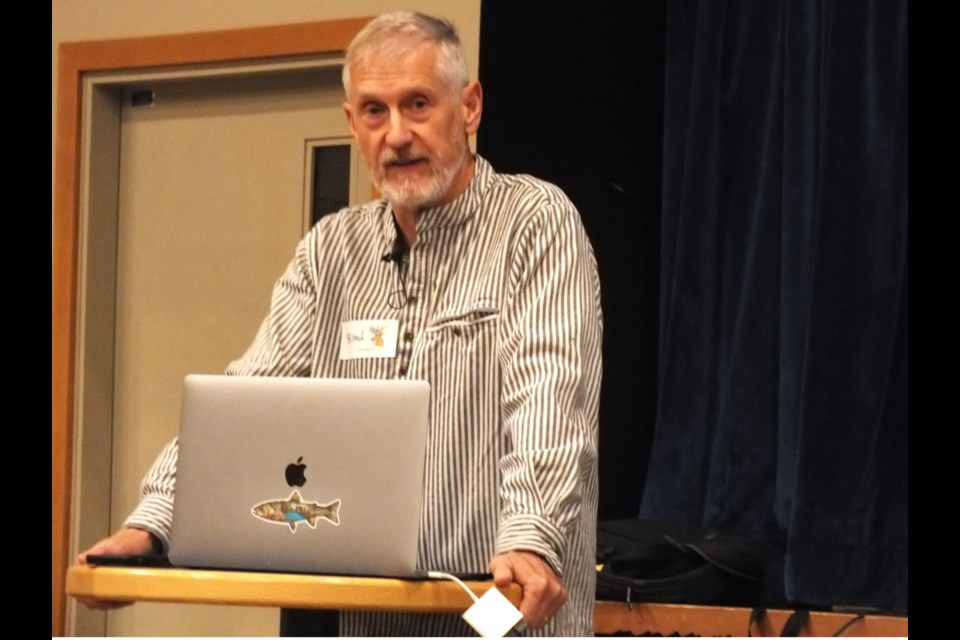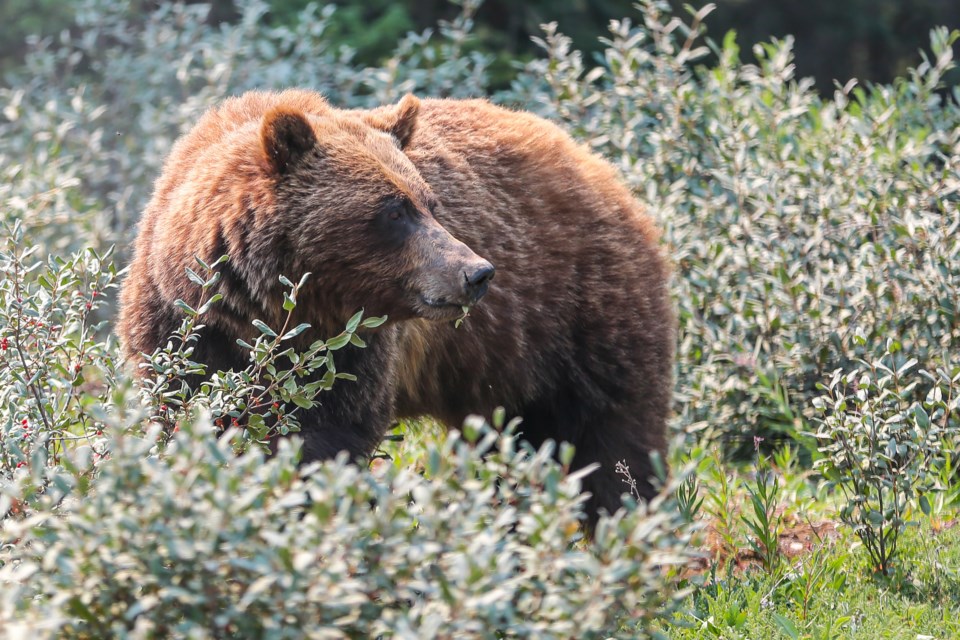According to landscape ecologist Dr. Brad Stelfox, the Greater Bragg Creek ecosystem is an absolutely iconic landscape where wildlife sightings are world class.
As if on cue, just prior to his presentation in Bragg Creek on May 22, a herd of elk was spotted five minutes away. Bragg Creek Wild, sponsors of the event, spoke with three different area residents about cougar sightings over the previous two days.
And one of Stelfox’s slides was a picture of a grizzly bear on May 6 as it ambled through the West Bragg Creek parking lot adjacent to where a BC logging company is planning on clearcutting next year, in the middle of one of the most heavily-used recreation areas in the province.
“There is a growing and significant amount of anxiety about a swing towards land uses that are modifying this landscape very quickly, and a new approach to decision-making may be in order.”
That was Stelfox’s opening overview to the crowd that gathered to hear the award-winning ecologist’s take on the need for a fundamental change in approach to land use.
“Although the people of this landscape I think are very good at dealing with the tactical, short-term issues, (insert slide of logging protesters gathered recently on Moose Mountain Road) we’re going to have to find a way to complement those with strategic thinking,” he said.
Issues come, he said, like the Flood of 2013, cougars eating dogs, clearcutting, and people react. Those upset about decisions need to think more broadly – more strategically. Otherwise there’s a danger of burning up personal energy and emotional capital by reacting to issue after issue.
Rather than managing land use in silos (forestry, energy, agriculture, recreation, etc.), Stelfox said we need a more comprehensive approach, based on natural capital.
“The landscape we’ve inherited here in the Upper Bow Basin is exceptionally complex – the slope, aspect, topography, precipitation – and this amazing diversity reflects itself in a broad spectrum of plant communities,” he said.
“And these plant communities translate into an absolutely stunning diversity of mammals. Over the last five generations there’s been a profound change in the amount of land use and the fragmentation of this landscape and the quality of what I call ecological goods and services.”
Stelfox is an adjunct professor in Biological Sciences at the University of Alberta and the Department of Environmental Design, University of Calgary. He and his family live in Calgary.
He is a recipient of a number of wildlife, ecological research, and environmental design awards.
In 2006, he was instrumental in the formation of the ALCES Group, a collection of landscape planners and resource analysts whose mission is to be a world leader in the delivery of land-use cumulative effects simulation modelling tools, and strategic land-use planning advice.
All that technical jargon means listening to him present his research is akin at times to drinking water from a fire hose.
Stelfox gained instant credibility with the crowd as a former Bragg Creek resident who misses hiking, biking and horseback riding there.
One tool he employed to powerful effect is the way he overlapped the personal with the technical.
Environmental literature is often laden with cautionary language appealing to the desire to consider, “what we are leaving our grandchildren.”
Stelfox wove his family into an explanation of how his research modelling tools work.
His time lapse projections of the consequences of certain land use choices on the Bragg Creek ecosystem appeared on screen over a moving bar along the bottom of a map of the area, measuring time not in numbers alone, but with photos.
The pictures were of himself at the start, followed by his daughter a few decades to the right, and then his one-year-old granddaughter appeared further down the timeline, coinciding with what she can expect the Bragg Creek area to look like as she ages, if current land uses (including clearcut logging) are allowed to proceed under existing rules.
It was an impressive bit of data presentation, and a powerful communication tool.
By the time she’s 30-years-old, the area looks a lot different.
The map of the study area, what he referred to as the Greater Bragg Creek ecosystem, shows Bragg Creek in the middle of a circle with a 17 km radius, covering 900 square kilometres. The edge of the area is 25 km from Calgary, which is growing quickly.
“There’s no other place on earth where you get this diversity of predators and ungulates within 100, let alone 30 km of a city of a million people. That’s like a Serengeti ecosystem dynamic and most Calgarians don’t even know about it.”
On any given day hikers in the Bragg Creek ecosystem might see a moose, two species of deer, black and grizzly bear, wolf, fox, cougar, bobcat, bison, elk, or coyote. And depending on where the boundaries are expanded to, they could add bighorn sheep, mountain goat, caribou and pronghorns to the list.
Stelfox said he’s convinced he’s seen wolverine tracks in the area as well. Badgers have been sighted.
Nowhere on earth, he said, offers such a diversity of large mammals so close to a major population centre.
He referred to a recent quote from Premier Danielle Smith, saying her government’s goal is to reach 10 million people by 2050, which translates into four million people in Calgary.
So the pressure on the Bragg Creek area for recreation alone is just going to mount.
When he saw the picture of the grizzly in West Bragg Creek, Stelfox said he got to thinking about what it must be like for a bear to navigate through an area that’s so heavily used by humans.
He said it’s just lucky that there’s been no mauling near Bragg Creek yet.
At the 40-minute mark, Stelfox said in the time he’d been talking, in Alberta, 72 hectares of forest had been cut down, 14 new well sites drilled, gas-powered vehicles travelled 39.2 million km, 4,105 tonnes of garbage produced, 10 ha of land converted to residential, and the population grew by 87.
“We need to lift our head out of the sand a little bit and start thinking about the future,” Stelfox said. “I’m just embarrassed that I’m part of the generation that created the problem that my grandkids and my kids are going to experience. We can do better.”
All land uses have benefits, Stelfox said, just as they all have liabilities. The key is to manage land use from economic, social and environmental perspectives at the same time. It’s all about trade-offs.
“We’ve been talking about it for decades. We don’t do it. We cannot continue to do everything everywhere all the time.”
Bragg Creek a case study for land use planners
He added the Bragg Creek area ecosystem is a microcosm of the challenge facing land use planners all over Alberta.
“It still has some phenomenal natural capital, and it will be lost if this community doesn’t find a way of integrating forestry and energy and agriculture and transportation and recreation and residential into a better argument.”
Bragg Creek Wild founder Renee Delorme, who invited Stelfox to speak, was upbeat.
“Brad’s presentation was all we’d hoped for. It was provocative, it was informative, it was sobering,” she said.
The presentation will be available for public viewing on the BCW website braggcreekwild.ca soon.
“But it also provided a way forward, for how we can address these issues and mitigate the trends that are slowly but surely degrading our ecosystem,” she said.
Delorme said people in the crowd were identifying with the message that we need to have the same passion for the natural capitol as others do for things like oil and gas and agriculture.
Living amongst the diversity of wildlife in Bragg Creek is living in paradise, she said.
“I grew up east of Ottawa. It was a big deal to see a groundhog.”





